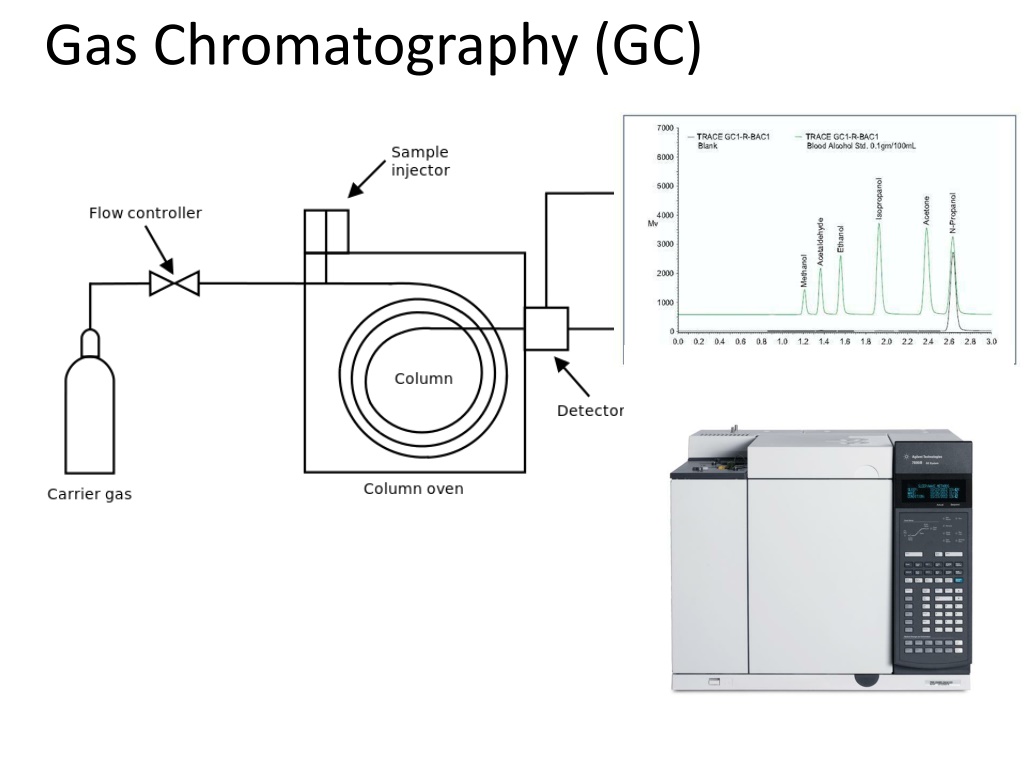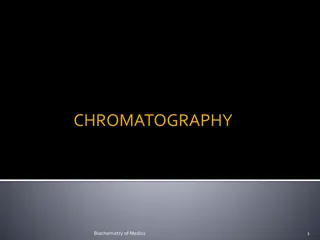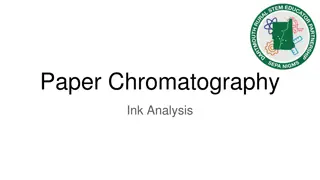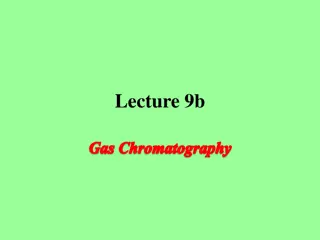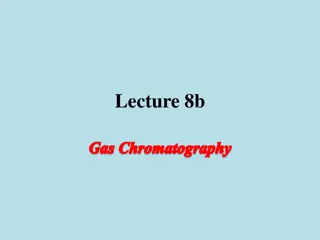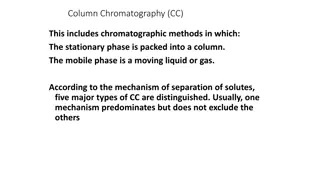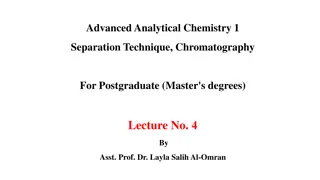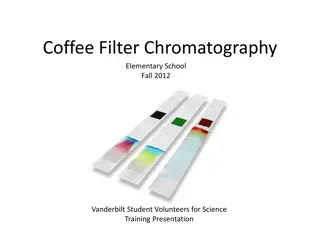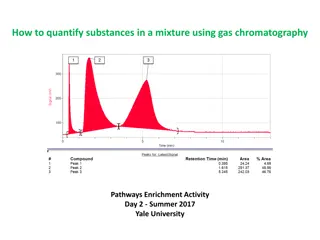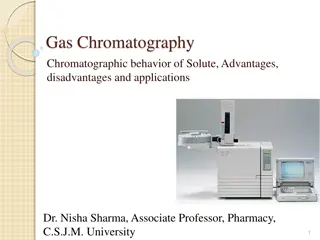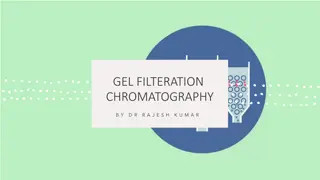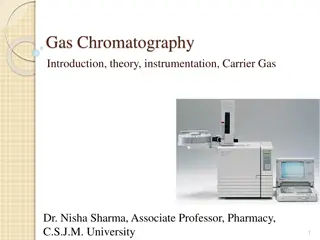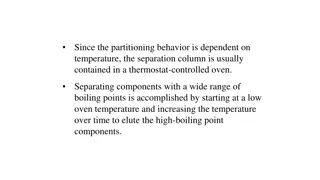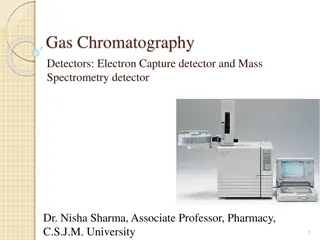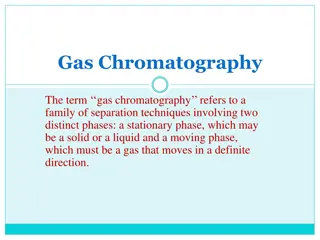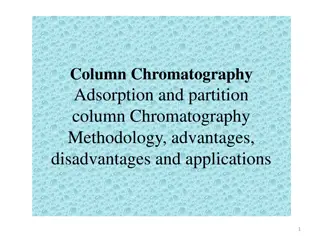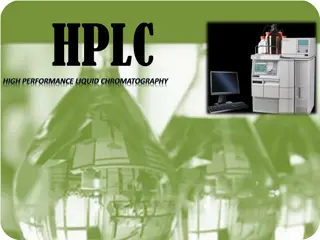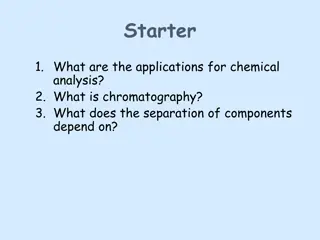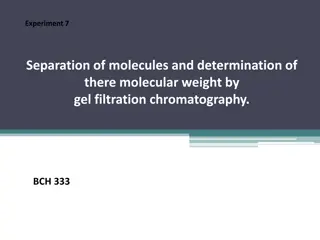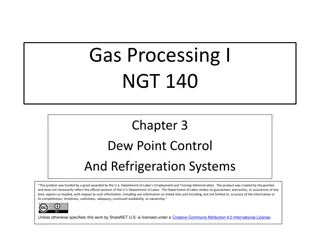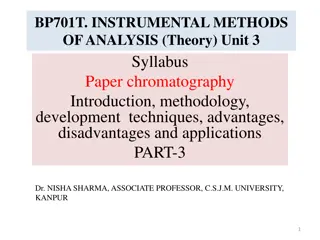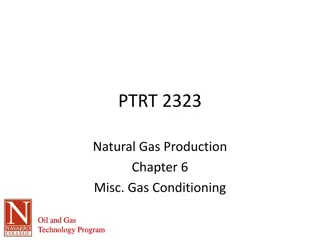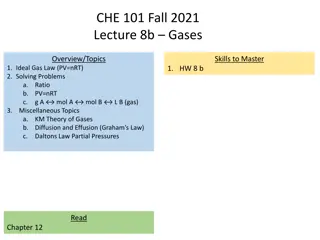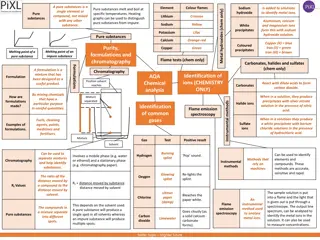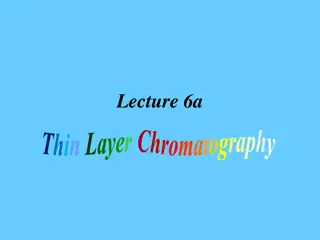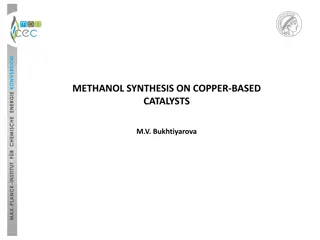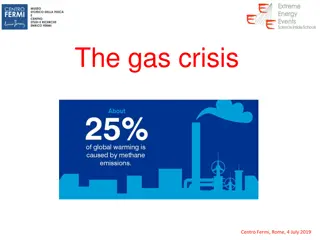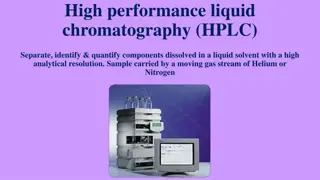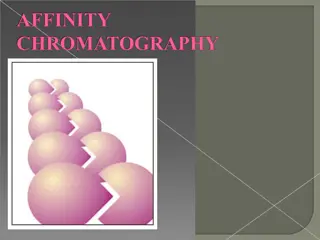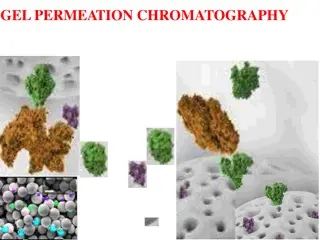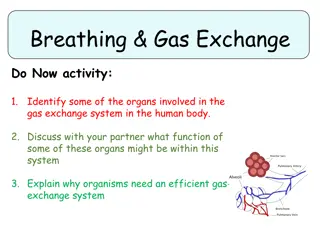Exploring Gas Chromatography Techniques
Gas chromatography (GC) is a valuable analytical technique used in various fields like forensics, environmental analysis, and pharmaceuticals. This technology allows for the separation and analysis of complex mixtures, such as detecting alcohol levels in breath or THC in cannabis. The origins of gas chromatography date back to the early 20th century, with advancements leading to modern instruments like the HP 5890A GC with FID detector. Packed glass columns play a crucial role in the process, showcasing the evolution of chromatography techniques over time.
Download Presentation

Please find below an Image/Link to download the presentation.
The content on the website is provided AS IS for your information and personal use only. It may not be sold, licensed, or shared on other websites without obtaining consent from the author. Download presentation by click this link. If you encounter any issues during the download, it is possible that the publisher has removed the file from their server.
E N D
Presentation Transcript
Alcohol Breathalyzer GC `apps in the real world Honestly, officer, I ain t drunknk Replaces old school `balloon test for alcohol
what is this portable GC detector looking for ??? Portable Cannabis (THC) GC detector
The ORIGINS OF GAS CHROMATOGRAPHY What chemicals are in ..??? ??????
First, easiest approach: Paper chromatography...separates bands (but hard to collect sample components) Chroma= color
The ORIGINS OF GAS CHROMATOGRAPHY: packed column separations Plant extract in ether/hexane mix Here, the ether/hexane mix is the `mobile phase I did this first ! Da! Da ! Packed column (originally packed with Confectioners sugar= `stationary phase ) Transducer= eyeball Russian Botanist Mikhail Tswett (1872-1919)
Packed glass columns can come in all kinds of sizes http://orgchem.colorado.edu/Technique/Procedures/Columnchrom/Images/Flash3.jpg http://info.ddpsinc.com/hs-fs/hub/47823/file-1025317014-jpg/images/Durapack_Columnmaxh=313,maxw=250,h=421,w=336.jpg http://yamazenusa.com/wp-content/themes/openair/images/ultrapack-2.jpg
Schematic of Typical Modern GasChromatograph (GC) Split flow : discard most (typical split 20:1 100:1) Measure output at selected transducer vs. background He Sample injection Detector Step down P from 1600 psi Level flow to fixed rate 50 Proportionating valve Data system and instrument control Flow controller GC column Column oven (thermal ramp) Primary Helium T t(min)
HP 5890A GC with FID detector We use single port injector, not auto samplers In HP 6890N GC (ASC): computer controls all flow and pressure via Chemstation
Main Components of a GC Plumbing to handle gases Column (heart of GC => separation) Oven (makes thermal ramp to produce SSS =Sharp, Symmetric, Separated peaks) Detectors (to see components once they are separated)
Plumbing Controlling the carrier flow part 1: Tank Valves secondary tank Valve File:Two-stage-regulator.svg primary secondary http://img.directindustry.com/images_di/photo-m2/0-125-psig-35-125-540-20592-3494071.jpg weaker spring Compensating springs Very strong spring Primary tank Valve controls here
Controlling the carrier flow part 2 old school: flow meters 10 mL mark A soap bubble flow meter (bubble-ometer) Compute flow: 10 mL/8 seconds= 1.25 mL/s =75 mL/min Soap solution in here He flow from test port of GC
Controlling the flow part 2:split-splitless inlet system- Modern way to control sample volume and carrier flowMost of He flow diverted to reduce flow into capillary
Plumbing part 3: Hooking things up National Pipe Thread (NPT) fittings tank fitments http://salestores.com/stores/images/images_747/CMA1512.jpg http://upload.wikimedia.org/wikipedia/commons/4/4a/Brass_NPT_threaded_Pipe_Plug_in_a_Caliper.jpg
Plumbing part 3 hookups :Swagelok fittings ferrule http://mtixtl.com/images/products/detail/sstubeadapter.jpg Nut Swagelok-NPT adapter Back cap FYI..ASC GC, MS and HPLC plumbing is all 3/16 OD and use 7/16 nut wrench
Plumbing part 3-hookups : Ferrules http://www.perkinelmer.com/CMSResources/Images/44-69937CapillaryColumnFerrulesGC85LG.jpg Ferrules for capillary columns are made of carbon (lower crush pressure) http://imagebank.osa.org/getImage.xqy?img=M3cubGFyZ2Usb2UtMTktMTYtMTUyNDQtZzAwNA
Columns-heart of a GC: There are 3 species Open, capillary (glass) Packed, Glass Packed, metal Packed: typically 0.3-2 m long, 3/16-1/4 OD, stationary phase on support (usually diatomaceous earth Open, 30-100 m long 0.25 mm ID, stationary phase on inside (0.2-0.3 um)
Jaap de Zeeuw, a Dutch chromatographer with Restak (commercial column manufacturer), holds the Guinness Record for longest capillary column in the world (1.3 km)
Columns (continued) Most common `FSWC type most common (Fused Silica Wall Coated Important acronym: MAOT = Maximum Operating Temperature (Typically < 400 oC) Beyond that, the stationary active phase delaminates or cooks off . (You see this in MS as siloxanes)
Column dimensions and MAOT written on column tag or box (Most stored on computer so that flow and pressures can be computed) (outside) (inside) 0.25 mm 0.35-0.37 mm 0.00025 mm
Columns (continued) `support = inner silica wall The liquid phase is the stationary phase. Physically `painted onto the silica (wall coated):Typical thickness are 0.25 m
Silica wall is often treated with silanizing agent to prevent sample sticking to it (a big problem early on with FSWC columns) Columns (continued) The silanized support is post-coated with the stationary phase and an initial thermal conditioning is applied to new columns to allow stationary phase and silanizing agent to bond/fuse
The GC Oven The GC oven is used to create thermal ramps
Whats a Thermal Ramp and why do we need it ? Sample mix injected at fixed temperature T=70 oC (isothermal) I(pA) Injected here time I(pA) Sample mix injected with thermal ramp applied (40 oC oC over 10 min => ramp=10 oC/min) 140 10 time 140 oC 40 oC
Thermal ramps help us achieve SSS GC peaks are: Sharp Symmetric Separated
A typical `real life thermal ramp and resultant chromatogram http://www.chromacademy.com/images/ScoutingGradient.jpg Held to bake/purge column Held at low T initially to stabilize column and lets lighter species get a head start
GC Ovenwhat it really looks like HP 6890 GC with single inject port GC Oven and Fan What s behind the white door A large thermally stable volume
Thermocouple GC Detectors (passive temperature change) The trusty Wheatstone bridge makes another appearance System is nulled when no sample through column side. The change in Voltage across `Signal means Column vs. Ref out of balance
Brief aside on the Wheatstone Bridge The details on how it works: http://cf.ydcdn.net/1.0.1.27/images/main/Wheatstone%20bridge.jpg A 1) Variable Rucreated by sample changing Ru . Syststem is initially `nulled by using Rv 0 ? I(mA) B Rv (Ru) 0 Rv(or time , t) 2) Current (or voltage) is plotted vs.time as resistance at Ru changes . This produces a signal dependent on Ru. As Ru changes in => spectrum or chromatogram
Wheatstone bridge details(continued) Using Kirchoff slaws for voltage and current sums at nodes Can solve for numerical value of Ru using the recipe (where Rv is at null point): http://cf.ydcdn.net/1.0.1.27/images/main/Wheatstone%20bridge.jpg Ru = Rv*R2 R1 I=0 Rv (Ru)
Wheatstone bridge details (cont.) What a basic Wheatstone bridge set-up really looks like http://www.djb.co.uk/Graphics/Physics/Electrical_Large/wheatstone_working.gif
Wheatstone bridge details (cont.) The `bridge is everywhere in modern equipment All digital voltmeters & voltage displays (DVM) Dynamic Base line (null) correction with op amp http://www.madshrimps.be/files/images/howto/NVIDIAGeforce8800OverclockingGuide-jmke-787.jpg http://m.eet.com/media/1173695/conditioning-techniques-for-real-world-sensors-fig-3.jpg micro pressure sensor : heart monitor Mechanical strain gauge https://encrypted-tbn2.gstatic.com/images?q=tbn:ANd9GcROK3jnCzcTlk9Sqf_SNsnk2BkaK-X4tOSU8_oNzr6jYO9kXATuig http://www.ibiblio.org/kuphaldt/electricCircuits/DC/00205.png
Wheatstone bridge details (cont.) http://upload.wikimedia.org/wikipedia/commons/7/7c/Charles_Wheatstone_later_years.jpg 185 years old and still awesome ,you snotnosed, young whippersnappers ! Wheatstone bridge is courtesy of Sir Charles Wheatstone 1833 !! Even if something is ancient, it doesn t mean it isn t awesome. The Wheatstone bridge is still one of the best ways to null a circuit.
FID=Flame Ionization Detector (what we use in ASC lab) Particularly good for Alkanes Alcohols Ketones, aldehydes Ethers Low weight aromatics http://www.shsu.edu/~chm_tgc/primers/FID_files/FID1.gif Less good for Large aromatics Herbicides Pesticides Organic acids
Basic Design of an FID (DC current in pA)
A real FID collector current out here Air + H2 in here Igniter (?) Sample with carrier gas in here
MSD Mass Selective Detector (also part of ASC detectors) Detector of choice in drug analysis (MSD IDs drugs) GC MSD
PID=Photoionization Detector (ASC got-no use for now) Blind to alcohols, alkanes, ketones (ALIPHATICS) http://www.shsu.edu/~chm_tgc/PID/PID.GIF Good with aromatics (including many herbicides and pesticides
Sketch of typical PID chromatogram 100 ppm toluene in ethanol I, pA ethanol time
ECD=Electron Capture Detector (ASC used to have..no $) 63 Ni* 63Cu + e- (radioactive decay of a beta particle=electron) e- + X X- causes change in current from background Is 10-1000X more sensitive than FID http://simg.rcdn.in/images/pages/280482/electron-capture-detector.jpg http://www.perkinelmer.com/CMSResources/Images/44-69977ECDGC35LG.jpg Particularly good with agricultural chemicals * (but generally useful) *Herbicides Pesticides Drawback: needs US Atomic Energy Commission Government License => $$$$
Common GC detectors summarized Detector What it detects best FID (Flame Ionization Detector) alkanes, alkenes, alcohols, ketones, aldehydes TCD (Thermocouple Detector) any compound with vapor pressure PID (Photoionization Detector) aromatics MSD(Mass Selective Detector) any compound with vapor pressure ECD(Electron Capture Detector) pesticides, herbicides
What do cats and chromatography scientists have in common ? Separation anxiety, of course !
